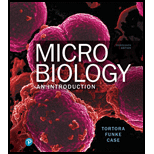
Concept explainers
The thermal death time for a suspension of Bacillus subtilis endospores is 30 minutes in dry heat and less than 10 minutes in an autoclave. Which type of heat is more effective? Why?
To review:
Which type of heat is more effective based on the thermal death time for a suspension of Bacillus subtilis endospores.
Introduction:
Bacillus subtilis is a rod-shaped, Gram-positive bacterium that are naturally found in soil and vegetation. B. subtilis grow in the mesophilic temperature range. The optimal temperature for the growth of this organism is 25ºC -35ºC.
Explanation of Solution
The cell wall is a rigid structure present outside the cell. Bacillus species are generally isolated by soil sprinkle technique and are used in the production of antibiotics. Ethanol, or strong acid or alkali are not effective in destroying the spores of B. subtilis. The use of chemicals generally does not kill the spores, and it only controls their growth and kills the living cells.
The effective way of destroying the endospores is by passing heat. Dry heat will take more time to penetrate through the cell. As moist heat easily penetrates through the cell, it is the effective way for the destruction of the endospores.
Based on the thermal death time (10 minutes) for B. subtilis endospores in an autoclave, moist heat is the effective method to kill B. subtilis endospores. In a sterilizing chamber, autoclave employs high temperature under pressure. It is used in the sterilization for surgical equipment and medical instruments. It is also used in pharmaceutical and food industries. The elevated temperature and pressure with steam creates an environment that is too high for any microorganisms or spores to live.
Moist heat penetrates into the bacterial cells easily and effectively kills vegetative bacteria as well as their spores. Compared to dry heat (thermal death time for B. subtilis endospores: 30 minutes), B. subtilis endospores are more effectively killed by an autoclave (moist heat).
Want to see more full solutions like this?
Chapter 7 Solutions
Microbiology: An Introduction (13th Edition)
Additional Science Textbook Solutions
Human Anatomy & Physiology (11th Edition)
HUMAN ANATOMY
Microbiology: Principles and Explorations
Human Physiology
Campbell Essential Biology (6th Edition) - standalone book
Campbell Biology: Concepts & Connections (8th Edition)
- A pure culture of an unknown bacterium was streaked onto plates of a variety of media. You notice that the colony morphology is strikingly different on plates of minimal media with glucose compared to that seen on trypticase soy agar plates. How can you explain these differences in colony morphology?arrow_forwardWhat color would Staphylococcus aureus cells be with the endospore stain shown in the photo?arrow_forwardWhat is sterilization? Give specific examples of media which are sterilized by the following methods:A. Boiling or heating onlyB. Autoclave using steam under pressure.C. Inspissatorarrow_forward
- Is the telluride glycine agar? (TGA) a complex or defined medium? Explain based on its composition. What kind of Media is TGA explaining based on what kind of microorganisms it allows to grow?arrow_forwardWhy does Bacillus subtilis break down phenol better even at high concentrations than E. coli and Pseudomonas putida?arrow_forwardOf what practical importance are air borne microorganisms to the laboratory workers? What precautions should be taken to control laboratory contaminants? Why are petri dishes incubated in an inverted position? Of what advantage is the using a solid and a liquid medium?arrow_forward
- Escherichia coli but not Pyrolobus fumarii will grow at 40°C,while P. fumarii but not E. coli will grow at 110°C. What ishappening (or not happening) to prevent growth of eachorganism at the nonpermissive temperature?arrow_forwardWhat is the hazard of the splattering tendency in flame sterilizing an inoculating loop? Can inoculation loops and needles be sterilized by autoclaving? Explain When is sterilization by filtration preferred over sterilization by heat? Why?arrow_forwardWhy would cells that are vigorously growing when inoculated into fresh culture medium have a shorter lag phase than those that have been stored in a refrigerator?arrow_forward
- Of what practical importance are air borne microorganisms to the laboratory workers? What precautions should be taken to control laboratory contaminants? Of what advantage is the using a solid and a liquid medium?arrow_forwardWhy do cells need to be kept in the freezing devices first then transferred to liquid nitrogen storage in crypto preservation? In addition, why are antibiotics not used in the cell freezing media? Why FBS concentration higher than 10% (10% is the standard concentration in complete growth media) is recommended in cell freezing media?arrow_forwardWhy is the time of exposure and temperature required for sterilization greater for dry heat than for autoclaving?arrow_forward
 Human Anatomy & Physiology (11th Edition)BiologyISBN:9780134580999Author:Elaine N. Marieb, Katja N. HoehnPublisher:PEARSON
Human Anatomy & Physiology (11th Edition)BiologyISBN:9780134580999Author:Elaine N. Marieb, Katja N. HoehnPublisher:PEARSON Biology 2eBiologyISBN:9781947172517Author:Matthew Douglas, Jung Choi, Mary Ann ClarkPublisher:OpenStax
Biology 2eBiologyISBN:9781947172517Author:Matthew Douglas, Jung Choi, Mary Ann ClarkPublisher:OpenStax Anatomy & PhysiologyBiologyISBN:9781259398629Author:McKinley, Michael P., O'loughlin, Valerie Dean, Bidle, Theresa StouterPublisher:Mcgraw Hill Education,
Anatomy & PhysiologyBiologyISBN:9781259398629Author:McKinley, Michael P., O'loughlin, Valerie Dean, Bidle, Theresa StouterPublisher:Mcgraw Hill Education, Molecular Biology of the Cell (Sixth Edition)BiologyISBN:9780815344322Author:Bruce Alberts, Alexander D. Johnson, Julian Lewis, David Morgan, Martin Raff, Keith Roberts, Peter WalterPublisher:W. W. Norton & Company
Molecular Biology of the Cell (Sixth Edition)BiologyISBN:9780815344322Author:Bruce Alberts, Alexander D. Johnson, Julian Lewis, David Morgan, Martin Raff, Keith Roberts, Peter WalterPublisher:W. W. Norton & Company Laboratory Manual For Human Anatomy & PhysiologyBiologyISBN:9781260159363Author:Martin, Terry R., Prentice-craver, CynthiaPublisher:McGraw-Hill Publishing Co.
Laboratory Manual For Human Anatomy & PhysiologyBiologyISBN:9781260159363Author:Martin, Terry R., Prentice-craver, CynthiaPublisher:McGraw-Hill Publishing Co. Inquiry Into Life (16th Edition)BiologyISBN:9781260231700Author:Sylvia S. Mader, Michael WindelspechtPublisher:McGraw Hill Education
Inquiry Into Life (16th Edition)BiologyISBN:9781260231700Author:Sylvia S. Mader, Michael WindelspechtPublisher:McGraw Hill Education





